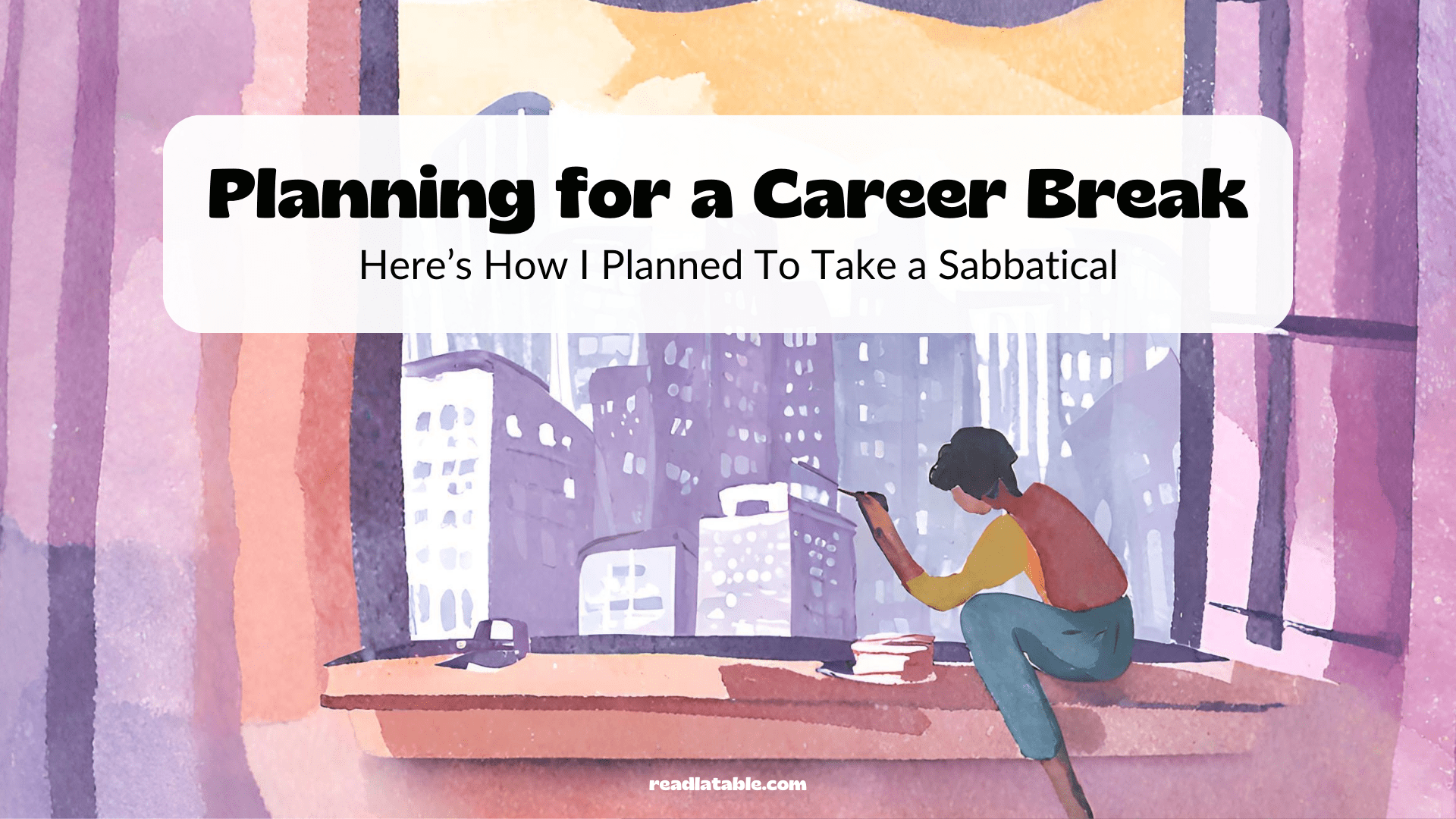Taking a career break or sabbatical is a dream for many people. The idea of stepping away from the daily grind and exploring new opportunities is enticing. However, many people fear taking a career break, believing that taking a break like this is not feasible or realistic.
In 2023, I finally took the leap and decided to take a career break. If this is something you’re considering for yourself, I’ll take you through what I did to plan for my career break, so that you can evaluate if this is something you’d like to do too!
Why I decided to take a career break

Source: Canva
My reason for taking a career break is simple: After working at my last job, I realised that I would be working in a corporate job for the next 40 years of my life. I wasn’t in a rush to climb the corporate ladder, and my past ambition of wanting to be Head of Marketing/part of the senior leadership in a workplace was no longer as enticing to me as before.
Instead of diving from one job to another, I wanted to take time to figure out if working a 9-5 job would be my end goal. Rather, I’ve always wondered if I could find alternative ways to make money while trying to live a more flexible lifestyle that gives me time to work on things that are more aligned with my values.
Here’s a basic step-by-step guide that I followed when I planned for my career break:
A Guide to Planning for My Career Break in Singapore

Source: Canva
Step One: Choose the Ideal Start Date and Duration
The first step in planning for a career break is to select the ideal start date and duration. It is essential to make this decision concrete by avoiding vague notions like “someday.” Instead, set a specific date and tie it to a significant life event, such as celebrating your 30th birthday or caring for your family when your baby arrives.
Discuss this plan with loved ones to make it feel real and gather valuable input. Remember, flexibility is key as you may need to revise the start date several times.
For myself, I decided to take a 2-year career break, with the following rough timeline for myself:
| Month / Year | Rough Timeline |
|---|---|
| April - December 2023 (8 months) | April - June: Take a break, explore hobbies July - December: Build freelance business, work on something concrete |
| January 2024 - January 2025 (1 year) | Working Holiday in New Zealand |
I gave myself 3 months to take a break, go traveling, and have time to adjust to a different pace of lifestyle. I also took this time to try out part-time jobs that I’ve always wanted to do, such as working as a pastry chef, and in a pottery studio.
During the first couple of months, I joined different start-up programmes to network and make friends, and simply took the time to meet people whose lives are very different from mine. Having a clear start and end date for your career break is important as it will help you better plan for your finances.
Step Two: Finances – Planning for Financial Stability

Source: Canva
Planning your finances is crucial before embarking on a career break. It is essential to assess your financial situation and determine how you will cover your everyday expenses during the break. Consider the following options:
- Debt Management: If you have any outstanding debts, prioritize paying them off before the break. Avoid adding new debt during this period.
- Savings: Establish a savings plan to ensure you have enough funds to pay yourself a salary during the break.
- Side Income: Generate a stream of side income before the break, so that you can earn enough to cover your expenses during this time.
- Part-Time Work: Consider working part-time during the break, taking on freelance projects or other flexible opportunities.
In addition, create an emergency fund to handle any unexpected expenses that may arise during your career break.
Here’s a quick look at how I planned my finances during this time:
1. Calculating My Monthly Expenses
Category Item Monthly Expenses
Home Expenses Mortgage Loan $913
SNCC $78
Electricity Bills $150
Groceries $350
Personal Personal Expenses $400
Insurance Insurance Premiums $434
TOTAL $2,325
2. Ensuring I have enough to cover $2,325/month worth of expenses
To do so, I made sure that I had enough CPF in my Ordinary Account to cover my mortgage loan, which is my biggest expense.
After projecting my finances, I figured I had enough in my CPF to cover my loan till December 2023. That means I have to figure out a way to earn ~$1,412/month to cover this year’s expenses, and $2,325/month for next year onwards.
Here are some part-time jobs that I’ve worked over the years to cover my expenses.
Step Three: Determine What You’ll Be Doing During Your Break

Source: Canva
While taking a break may seem like an opportunity to relax and do nothing, it is important to have a plan for how you will spend your time. Consider the following ideas:
- Pursue Your Passion: Use this time to explore your interests, whether it’s traveling, gardening, reading, writing, or volunteering.
- Discover New Interests: Experiment with different activities to uncover new passions and hobbies.
- Family Focus: If raising a family is a priority, dedicate your break to spending quality time with your loved ones.
- Educational Pursuits: Consider going back to school to gain new skills or knowledge in a specific field.
- Career Change: Use the break to explore a new career path, such as entrepreneurship or freelancing.
- Bucket List: Tick off items from your bucket list that you’ve been longing to experience.
Remember that the planning process for your break activities may take time. It’s important to start brainstorming and exploring your options while simultaneously taking care of your financial preparations.
For my own career break, here are the main goals that I’ve set out to achieve:
| Category | Goal |
|---|---|
| Life | To take the time to explore an alternative lifestyle - Live in another country - Take on jobs that I don’t have the opportunity to in Singapore (farming, fruit picking) |
| Self-Growth / Career | Learn to build something from 0-1 Create something that aligns with my values Figure out a way to monetise my own platform and skillset (marketing) to earn a modest wage |
| Hobbies & Passions | Continue doing pottery and make it into a serious hobby |
Step Four: Prepare Your Exit Strategy

Source: Canva
As the date approaches, it’s time to prepare your exit strategy from your current job. Here are some things to take note of when exiting your job:
- Conversation with Your Boss: Have an open and honest conversation with your supervisor about your decision. Depending on your relationship with your boss, share your plans early on.
- Company Policies: Familiarise yourself with your company’s policies regarding sabbaticals or unpaid leaves of absence. For me, I resigned from my job to take a career break as my timeline of 2 years was too long to take a leave of absence. If you’re planning to take a shorter career break, you can explore taking unpaid leave as an option.
- Explore Alternative to Full-Time Employment at Your Current Company: In my case, I managed to get a part-time arrangement with my current employer for 4-5 months after resigning from my job. This ensures a smooth transition for the company. The additional allowance also with my expenses for a period of time.
- Resignation: If negotiating a break is not possible or desirable, resign from your position gracefully. Give proper notice, train your replacements, and submit a cordial resignation letter.
By planning your exit strategy carefully, you can ensure a smooth transition and maintain positive relationships with your current employer.
Step Five: Embrace Your Career Break

Source: Canva
Finally, the moment arrives to embark on your career break. Here are some tips to make the most of your time off:
1. Expect Cold Feet
It’s natural to feel anxious or uncertain when the break is about to begin. Remind yourself of the reasons behind your decision and stay focused on the opportunities that lie ahead.
2. It’s Okay To Feel Left Behind
One of the biggest things I struggled with on my career break is seeing my friends get promoted, or get a pay raise while I’m not earning as much. While I’m happy for my friends, it is easy to feel left behind while others move ahead with their careers.
If you feel the same way, take comfort in the fact that you decided to go into a career break for a good reason.
At the end of the day, why would you want to do the same thing as everyone else, if you want to have a different outcome from what everyone else has?
3. Transit Gradually
Consider easing into your new lifestyle by taking a few days off each week in the weeks leading up to your break. This will help you adjust and test the waters.
4. Have a Structured Plan
Plan the first few weeks of your break in detail to ensure a smooth transition. Whether it’s spending time with family or diving into your new projects, having a structured plan will help you settle into your new routine.
5. Socialise and Connect
Make a conscious effort to stay connected with friends, family, and like-minded individuals. Join relevant forums or communities, schedule regular meetups, and engage in conversations to avoid isolation.
Remember, a career break is an opportunity for personal growth and exploration. Embrace the freedom and make the most of this time to discover new paths and pursue your passions.

